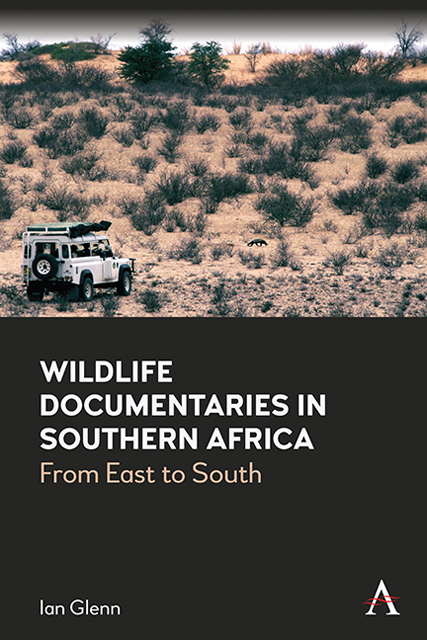Book contents
- Frontmatter
- Dedication
- Contents
- List of Figures
- Acknowledgements
- Introduction
- Chapter 1 What do the Critics Say?
- Chapter 2 A Theoretical Coalition?
- Chapter 3 Gone South: From East to Southern Africa
- Chapter 4 Private Lodges, Infrastructures and Guides
- Chapter 5 Going South: The Results
- Chapter 6 The Early History
- Chapter 7 The South Africans Enter the Game
- Chapter 8 Michael Rosenberg and Partridge Films
- Chapter 9 David and Carol Hughes
- Chapter 10 The Bartletts in the Namib, the Liversedges in Botswana
- Chapter 11 John Varty, Elmon Mhlongo and Londolozi
- Chapter 12 Richard Goss and Kim Wolhuter
- Chapter 13 Dereck and Beverly Joubert
- Chapter 14 Other Major Contributors
- Chapter 15 Going Live: Africam And Wildearth
- Chapter 16 Craig and Damon Foster
- Chapter 17 Must Love Animals?
- Chapter 18 The Social Turn
- Chapter 19 The Future of the Genre
- Chapter 20 The Influence of the Genre
- Conclusion
- Filmography
- Plates
- References
- Index
Chapter 16 - Craig and Damon Foster
Published online by Cambridge University Press: 10 January 2023
- Frontmatter
- Dedication
- Contents
- List of Figures
- Acknowledgements
- Introduction
- Chapter 1 What do the Critics Say?
- Chapter 2 A Theoretical Coalition?
- Chapter 3 Gone South: From East to Southern Africa
- Chapter 4 Private Lodges, Infrastructures and Guides
- Chapter 5 Going South: The Results
- Chapter 6 The Early History
- Chapter 7 The South Africans Enter the Game
- Chapter 8 Michael Rosenberg and Partridge Films
- Chapter 9 David and Carol Hughes
- Chapter 10 The Bartletts in the Namib, the Liversedges in Botswana
- Chapter 11 John Varty, Elmon Mhlongo and Londolozi
- Chapter 12 Richard Goss and Kim Wolhuter
- Chapter 13 Dereck and Beverly Joubert
- Chapter 14 Other Major Contributors
- Chapter 15 Going Live: Africam And Wildearth
- Chapter 16 Craig and Damon Foster
- Chapter 17 Must Love Animals?
- Chapter 18 The Social Turn
- Chapter 19 The Future of the Genre
- Chapter 20 The Influence of the Genre
- Conclusion
- Filmography
- Plates
- References
- Index
Summary
Background
After schooling in Cape Town and compulsory military service where they were placed in the South African navy’s film unit, Craig and Damon Foster looked as though they might follow the example of many young white English-speaking South Africans and leave the country. But they were drawn back in part by the initiative of a school friend James Hersov who wanted to make a documentary film about the San and managed to get the support of CocaCola. The brothers spent several years in the Kalahari with the San and two films resulted.
The first film, Tracks (1999), centred on the theories and technological innovation of South African tracking expert and theorist Louis Liebenberg and on attempts to use San expertise and Liebenberg’s Cybertracker software for the cause of conservation. This version also used American National Wildlife Federation representative Judith Kohler as a commentator who argued that San knowledge of the Kalahari provided a more holistic and profound understanding of the area than western science. The second film was The Great Dance (2000) which was a surprise winner of the Golden Panda for best wildlife documentary in 2000 (Figure 16.1). A comparison of the expository style of the earlier film with the poetic style and narration of the later one helps understand how the Foster brothers’ views and interests shifted and how this shift shaped their later film careers.
Tracks
The earlier film uses several narrators whose views are in narrative and visual tension. The opening of the film offers a glimpse of mystical powers as a narrator says that people dream of being among animals and invisible to them, but that the San, through their tracking ability and what it reveals of animal behaviour and movements, can actually do that. ‘Mystical narrator’ says that the San can transform themselves in the dance.
The second narrator is Louis Liebenberg and for him the film was a way of at once expanding on his influential hypothesis of tracking as the origin of scientific hypothesis formation (Liebenberg 1990) but also of showing the advantages of his patented Cybertracker software as a way for the San to serve conservation by logging the presence of animals through their tracks.
- Type
- Chapter
- Information
- Wildlife Documentaries in Southern AfricaFrom East to South, pp. 205 - 212Publisher: Anthem PressPrint publication year: 2022

